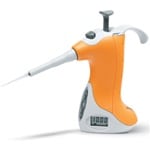Pipetting is one of the most repetitive tasks in the laboratory. Pipettes are critical tools to transport a measured volume of liquid. Also, the number of applications that use this liquid handling tool is growing at a rapid pace. However, several reports have proven that repetitive pipetting may lead to upper limb problems. For those who work in laboratories, the number one cause for work-related musculoskeletal disorders is the use of pipettes. Ergonomics is a major factor to consider while choosing pipettes. Some of the most common risk factors leading to musculoskeletal disorders are repetition, force, posture, vibration and temperature.
Ergonomic issues often associated with pipetting includes upper arm flexion between 45° - 90°, frequent abduction of the arm, repetitive movement of the forearm often through full range-of-motion, application & removal of pipette tips requiring high hand and arm forces, repetitive applications of force with the thumb and frequent pinch grips to open vials, pick-up tubes.
Ergonomically designed pipettes offered by established manufacturers like VistaLab Technologies are ideal to minimize the risk factors so common with traditional pipettes. Such devices fit comfortably in the open hand, and effortlessly reinforce correct pipetting postures. They provide various advantages such as:
- Minimized tension and fatigue
- Reduced exertion and contact stress
- Low contact pressure
- Lowest pressure on carpal tunnel and to median nerve
- Minimized tension to shoulder and elbow
VistaLab Ovation pipettes feature unmatched patented ergonomic design and come with audible "click" tip attachment to ensure consistent loading, easy spring-loaded "flick" tip ejection for low thumb force, color coded body for easy volume identification and in-lab calibration adjustment. Electronic Single Channel (ESC) units are suitable for programmable functions for multi-dispensing, serial dilutions, mixing, reverse pipetting and pipetting speed. Electronic pipettes use a motor to control the plunger, removing many motions and considerable physical stress on the thumb, hand and forearm. Automatic operation, light weight construction, increased handle comfort and low maintenance make these units an attractive choice for any laboratory.



